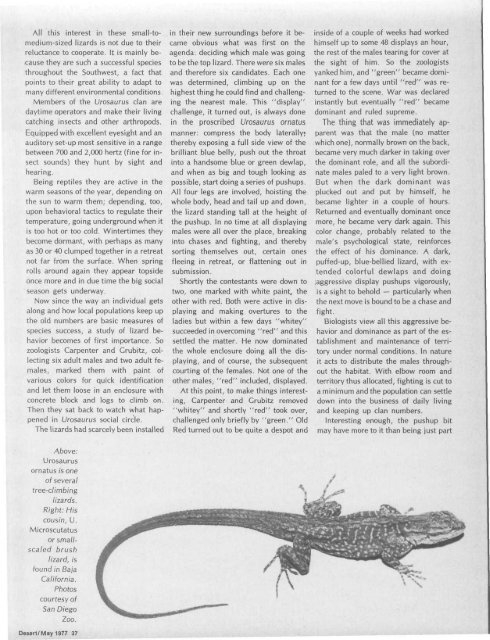books - Desert Magazine of the Southwest
books - Desert Magazine of the Southwest
books - Desert Magazine of the Southwest
Create successful ePaper yourself
Turn your PDF publications into a flip-book with our unique Google optimized e-Paper software.
All this interest in <strong>the</strong>se small-tomedium-sized<br />
lizards is not due to <strong>the</strong>ir<br />
reluctance to cooperate. It is mainly because<br />
<strong>the</strong>y are such a successful species<br />
throughout <strong>the</strong> <strong>Southwest</strong>, a fact that<br />
points to <strong>the</strong>ir great ability to adapt to<br />
many different environmental conditions.<br />
Members <strong>of</strong> <strong>the</strong> Urosaurus clan are<br />
daytime operators and make <strong>the</strong>ir living<br />
catching insects and o<strong>the</strong>r arthropods.<br />
Equipped with excellent eyesight and an<br />
auditory set-up most sensitive in a range<br />
between 700 and 2,000 hertz (fine for insect<br />
sounds) <strong>the</strong>y hunt by sight and<br />
hearing.<br />
Being reptiles <strong>the</strong>y are active in <strong>the</strong><br />
warm seasons <strong>of</strong> <strong>the</strong> year, depending on<br />
<strong>the</strong> sun to warm <strong>the</strong>m; depending, too,<br />
upon behavioral tactics to regulate <strong>the</strong>ir<br />
temperature, going underground when it<br />
is too hot or too cold. Wintertimes <strong>the</strong>y<br />
become dormant, with perhaps as many<br />
as 30 or 40 clumped toge<strong>the</strong>r in a retreat<br />
not far from <strong>the</strong> surface. When spring<br />
rolls around again <strong>the</strong>y appear topside<br />
once more and in due time <strong>the</strong> big social<br />
season gets underway.<br />
Now since <strong>the</strong> way an individual gets<br />
along and how local populations keep up<br />
<strong>the</strong> old numbers are basic measures <strong>of</strong><br />
species success, a study <strong>of</strong> lizard behavior<br />
becomes <strong>of</strong> first importance. So<br />
zoologists Carpenter and Grubitz, collecting<br />
six adult males and two adult females,<br />
marked <strong>the</strong>m with paint <strong>of</strong><br />
various colors for quick identification<br />
and let <strong>the</strong>m loose in an enclosure with<br />
concrete block and logs to climb on.<br />
Then <strong>the</strong>y sat back to watch what happened<br />
in Urosaurus social circle.<br />
The lizards had scarcely been installed<br />
Above:<br />
Urosaurus<br />
ornatus is one<br />
<strong>of</strong> several<br />
tree-climbing<br />
lizards.<br />
Right: His<br />
cousin, U.<br />
Microscutatus<br />
or smallscaled<br />
brush<br />
lizard, is<br />
found in Baja<br />
California.<br />
Photos<br />
courtesy <strong>of</strong><br />
San Diego<br />
Zoo.<br />
<strong>Desert</strong>/May 1977 37<br />
in <strong>the</strong>ir new surroundings before it became<br />
obvious what was first on <strong>the</strong><br />
agenda: deciding which male was going<br />
to be <strong>the</strong> top lizard. There were six males<br />
and <strong>the</strong>refore six candidates. Each one<br />
was determined, climbing up on <strong>the</strong><br />
highest thing he could find and challenging<br />
<strong>the</strong> nearest male. This "display"<br />
challenge, it turned out, is always done<br />
in <strong>the</strong> proscribed Urosaurus ornatus<br />
manner: compress <strong>the</strong> body laterally;<br />
<strong>the</strong>reby exposing a full side view <strong>of</strong> <strong>the</strong><br />
brilliant blue belly, push out <strong>the</strong> throat<br />
into a handsome blue or green dewlap,<br />
and when as big and tough looking as<br />
possible, start doing a series <strong>of</strong> pushups.<br />
All four legs are involved, hoisting <strong>the</strong><br />
whole body, head and tail up and down,<br />
<strong>the</strong> lizard standing tall at <strong>the</strong> height <strong>of</strong><br />
<strong>the</strong> pushup. In no time at all displaying<br />
males were all over <strong>the</strong> place, breaking<br />
into chases and fighting, and <strong>the</strong>reby<br />
sorting <strong>the</strong>mselves out, certain ones<br />
fleeing in retreat, or flattening out in<br />
submission.<br />
Shortly <strong>the</strong> contestants were down to<br />
two, one marked with white paint, <strong>the</strong><br />
o<strong>the</strong>r with red. Both were active in displaying<br />
and making overtures to <strong>the</strong><br />
ladies but within a few days "whitey"<br />
succeeded in overcoming "red" and this<br />
settled <strong>the</strong> matter. He now dominated<br />
<strong>the</strong> whole enclosure doing all <strong>the</strong> displaying,<br />
and <strong>of</strong> course, <strong>the</strong> subsequent<br />
courting <strong>of</strong> <strong>the</strong> females. Not one <strong>of</strong> <strong>the</strong><br />
o<strong>the</strong>r males, "red" included, displayed.<br />
At this point, to make things interesting,<br />
Carpenter and Crubitz removed<br />
"whitey" and shortly "red" took over,<br />
challenged only briefly by "green." Old<br />
Red turned out to be quite a despot and<br />
inside <strong>of</strong> a couple <strong>of</strong> weeks had worked<br />
himself up to some 48 displays an hour,<br />
<strong>the</strong> rest <strong>of</strong> <strong>the</strong> males tearing for cover at<br />
<strong>the</strong> sight <strong>of</strong> him. So <strong>the</strong> zoologists<br />
yanked him, and "green" became dominant<br />
for a few days until "red" was returned<br />
to <strong>the</strong> scene. War was declared<br />
instantly but eventually "red" became<br />
dominant and ruled supreme.<br />
The thing that was immediately apparent<br />
was that <strong>the</strong> male (no matter<br />
which one), normally brown on <strong>the</strong> back,<br />
became very much darker in taking over<br />
<strong>the</strong> dominant role, and all <strong>the</strong> subordinate<br />
males paled to a very light brown.<br />
But when <strong>the</strong> dark dominant was<br />
plucked out and put by himself, he<br />
became lighter in a couple <strong>of</strong> hours.<br />
Returned and eventually dominant once<br />
more, he became very dark again. This<br />
color change, probably related to <strong>the</strong><br />
male's psychological state, reinforces<br />
<strong>the</strong> effect <strong>of</strong> his dominance. A dark,<br />
puffed-up, blue-bellied lizard, with extended<br />
colorful dewlaps and doing<br />
;aggressive display pushups vigorously,<br />
is a sight to behold — particularly when<br />
<strong>the</strong> next move is bound to be a chase and<br />
fight.<br />
Biologists view all this aggressive behavior<br />
and dominance as part <strong>of</strong> <strong>the</strong> establishment<br />
and maintenance <strong>of</strong> territory<br />
under normal conditions. In nature<br />
it acts to distribute <strong>the</strong> males throughout<br />
<strong>the</strong> habitat. With elbow room and<br />
territory thus allocated, fighting is cut to<br />
a minimum and <strong>the</strong> population can settle<br />
down into <strong>the</strong> business <strong>of</strong> daily living<br />
and keeping up clan numbers.<br />
Interesting enough, <strong>the</strong> pushup bit<br />
may have more to it than being just part

















